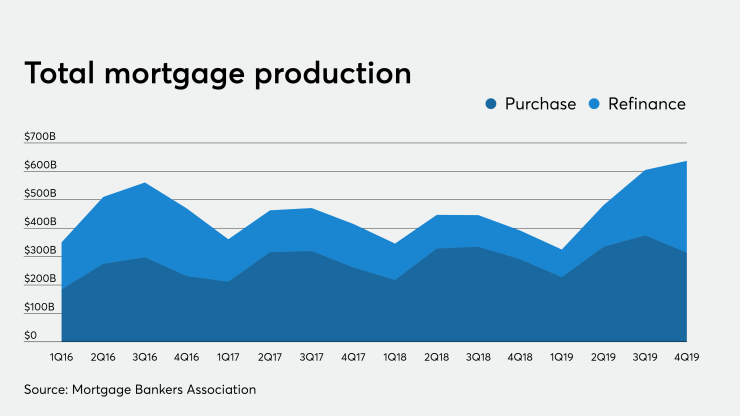The housing sector was barely mentioned
Congress did not deign to actually deal with the implications of granting a legal payment holiday of up to a year on $11 trillion in agency mortgages in the
Simply stated, the federal holiday for housing payments is perhaps the largest unfunded public mandate in American history. If you spread a 3.5% coupon across $11.6 trillion in single family mortgages, that comes to about $34 billion a month in principal and interest payments alone.
Neither Congress nor federal agencies, at this writing, seem to know how or even whether these payment holidays will be processed or financed. Little details like the duration of the assistance, the proper process for documentation and the payment of little items like property taxes and insurance have been omitted in the mad rush by Congress to flee Washington.

There are two components to the payment assistance effort when it comes to housing. First there is the question of how to account for the missed mortgage payment. As this writer argued in a recent blog post (
This way, the consumer's credit is not impaired, the loan remains in the agency mortgage backed security and investors continue to receive principal and interest payments. But now comes the hard part, namely funding.
"Should HUD/FHA stick with their current post-forbearance plan and rely on loan modification that requires the servicer to buy out the loan early from the pool?" we asked, reflecting the views of executives at several large government issuers we contacted over the weekend.
"If, as many issuers anticipate, over 25% of all Ginnie Mae loans take advantage of the forbearance program, prepay speeds will accelerate dramatically. This will be followed by a slew of new issuance of seasoned loans recently off forbearance programs. This is a lot of paperwork for nothing."
Mortgage loan servicers have a duty to advance principal and interest when the borrower fails to pay. While some have spoken about putting in place a scheme to reimburse servicers for the arrears, and we wrote about same this week, the government lacks the capacity to actually implement the proposal.
Former Ginnie Mae President Ted Tozer, who is now a fellow at the Milken Institute and sits on the board of directors of Penny Mac, believes that a more practical solution is for the mortgage industry to fashion an approach to financing missed loan payments on all agency loans that utilizes existing infrastructure for funding advances.
Tozer said he proposed to the Trump administration that payments of interest and principal on all agency, Fannie Mae, Freddie Mac and Ginnie Mae, loans be financed as by the U.S. banking sector as an advance at zero percent interest to the servicer. The missed payment on the loan will be documented by the lender and recorded in the servicing system as due upon sale of the house. Banks would be paid a fee for arranging the advance, which would be financed by the Federal Reserve System and the Treasury, with the central bank in the senior position. The Fed could even pay the banks the rate paid on excess reserves.
This arrangement deals with the funding of the missed payment and, most important, the eventual return of the missed P&I payment on the mortgage, perhaps years down the road. The missed payments would simply be carried as an advance asset for the banks, with the guarantee of the Treasury and the underlying asset as the security.
The Fed would provide the liquidity for this arrangement, says Tozer, but would be largely isolated from credit risk. And most important, the advance would include property taxes and insurance, thus protecting both the house and the finances of the communities where they are located.
The appeal of Tozer's well-considered approach is that it deals systemically with the question of documenting the missed loan payment and also provides a way to finance these payments going through time. Merely focusing on dealing with the short-term liquidity needs misses the point, says Tozer, since we will need to finance the arrears for the long-term.
The question of funding is not trivial. Most servicers contacted this week report that consumers are requesting payment holidays at an accelerating rate. For the month of March, many will report participation rates somewhere in the high single digits of total loans serviced.
They anticipate that consumer rates of participation will continue to rise to the 20-30% range by the end of April. Subservicers are already starting to raise fees charged to REITs and other investors in mortgage assets based upon higher delinquencies.
While mortgage servicers, banks and nonbanks alike, probably have sufficient liquidity to make payments of principal and interest in April, the following month is problematic. The assistance program
One senior commercial banker said that a proposed six-month window with an immediate 30% default rate generates a market (bank and nonbank) cash advance obligation of approximately $100 billion. The idea of financing the arrears, rather than claiming them for reimbursement via the GSEs, seems to be gaining support if for no other reason than it is practical.
"Leaving banks aside for the moment," argues the mortgage banker, "few, if any, nonbank servicers have sufficient liquidity to support funding even a limited number of relief periods." The veteran banker suggests that some type of comprehensive financing solution for P&I and T&I payments must occur, most likely implemented by the banks to ensure the agency MBS is paid.
Kevin Wack
The good news is that Congress and the White House, in tandem, are slowly becoming aware of the issue of liquidity. The Financial Stability Oversight Council has been tasked with recommending a solution. There seems to be a consensus forming in the industry around some type of funding mechanism to keep the payments flowing and thereby avoid a default on an agency MBS. The wheels turn slowly in Washington, but they do turn.





